Chapter 10
Math Fundamentals
Numbers and equations form the basis of all the math questions on the GRE. Simply put, the more comfortable you are working with numbers and equations, the easier the math portion of the exam will be. This chapter gives you a review of all the basic mathematical concepts including properties of numbers, factors and multiples, fractions and decimals, math vocabulary, and some basic rules of math.
GET FAMILIAR
To do well on the GRE Math section, you’ll have to be comfortable working with numbers. The concepts tested on the GRE are not exceptionally difficult, but if you are even the least bit skittish about numbers you’ll have a harder time working the problems.
This chapter will familiarize you with all the basics you need to know about numbers and how to work with them. If you’re an arithmophobe or haven’t used math in a while, take it slowly and make sure you’re comfortable with this chapter before moving onto the succeeding ones.
GRE MATH VOCABULARY
Quick—what’s an integer? Is 0 even or odd? How many even prime numbers are there?
Before we go through our techniques for specific types of math problems, we’ll acquaint ourselves with some basic vocabulary and properties of numbers. The GRE loves to test your knowledge of integers, fractions, decimals, and all those other concepts you probably learned years ago. Make sure you’re comfortable with the topics in this chapter before moving on. Even if you feel fairly at ease with number concepts, you should still work through this chapter. ETS is very good at coming up with questions that require you to know ideas forwards and backwards.
The math terms we will review in this section are very simple, but that doesn’t mean they’re not important. Every GRE math question uses simple terms, rules, and definitions. You absolutely need to know this math “vocabulary.” Don’t worry; we will cover only the math terms that you must know for the GRE.
Digits
Digit refers to the numbers that make up other numbers. There are 10 digits: 0, 1, 2, 3, 4, 5, 6, 7, 8, 9, and every number is made up of one or more digits. For example, the number 10,897 has five digits: 1, 0, 8, 9, and 7. Each of the digits in a number has its own name, which is designated by a place value. In the number 10,897
• 7 is the ones or units digit.
• 9 is the tens digit.
• 8 is the hundreds digit.
• 0 is the thousands digit.
• 1 is the ten-thousands digit.
Numbers
A number is made up of either a digit or a collection of digits. There are, of course, an infinite number of numbers. Basically, any combination of digits you can imagine is a number, which includes 0, negative numbers, fractions and decimals, and even weird numbers such as  .
.
Integers
The integers are the numbers that have no fractional or decimal part, such as −6, −5, −4, −3, −2, −1, 0, 1, 2, 3, 4, 5, 6, and so on.
Notice that fractions, such as  , are not integers.
, are not integers.
Remember that the number zero is an integer! The values of positive integers increase as they move away from 0 (6 is greater than 5); the values of negative integers decrease as they move away from zero (−6 is less than −5).
PROPERTIES OF NUMBERS AND INTEGERS
Now that you’ve learned the proper names for various types of numbers, let’s look at properties of numbers and integers.
Positive or Negative
Numbers can be positive or negative. Negative numbers are less than zero, while positive numbers are greater than zero. Zero itself is neither positive nor negative—all other numbers are either positive or negative.
Even or Odd
Only integers possess the property of being even or odd. Fractions, decimals, and other non-integers cannot be described as even or odd. Integers that are even are those that are divisible by 2; odd integers are those integers that are not divisible by 2. Put another way, even integers have a remainder of 0 when divided by 2 while odd integers have a remainder of 1 when divided by 2.
• Here are some even integers: −4, −2, 0, 2, 4, 6, 8, 10.
• Here are some odd integers: −3, −1, 1, 3, 5, 7, 9, 11.
Zero
Zero is a special little number. It is an integer, but it is neither positive nor negative. However, try to remember these facts about zero:
• 0 is even.
• 0 plus any other number is equal to that other number.
• 0 multiplied by any other number is equal to 0.
• You cannot divide by 0.
Keep in Mind
• Fractions are neither even nor odd.
• Any integer is even if its units digit is even; any integer is odd if its units digit is odd.
• The results of adding and multiplying odd and even integers are as follows:
○ even + even = even
○ odd + odd = even
○ even + odd = odd
○ even × even = even
○ odd × odd = odd
○ even × odd = even
If you have trouble remembering some of these rules for odd and even, don’t worry. As long as you remember that there are rules, you can always figure them out by plugging in numbers. Let’s say you forget what happens when an odd number is multiplied by an odd number. Just pick two odd numbers, say 3 and 5, and multiply them. 3 × 5 = 15. Now you know: odd × odd = odd.
Consecutive Integers
Consecutive integers are integers listed in order of increasing value without any integers missing in between them. Here are some examples:
• 0, 1, 2, 3, 4, 5
• −6, −5, −4, −3, −2, −1, 0
• −3, −2, −1, 0, 1, 2, 3
By the way, fractions and decimals cannot be consecutive, only integers can be consecutive. However, you can have different types of consecutive integers. For example consecutive even integers could be 2, 4, 6, 8, 10. Consecutive multiples of four could be 4, 8, 12, 16.
Absolute Value
The absolute value of a number is equal to its distance from 0 on the number line, which means that the absolute value of any number is always positive, whether the number itself is positive or negative. The symbol for absolute value is a set of double lines: | |. Thus |−5| = 5, and |5| = 5 because both −5 and 5 are a distance of 5 from 0 on the number line.
FACTORS, MULTIPLES, AND DIVISIBILITY
Now let’s look at some ways that integers are related to each other.
Factors
A factor of a particular integer is a number that will divide evenly into the integer in question. For example, 1, 2, 3, 4, 6, and 12 are all factors of 12 because each number divides evenly into 12. In order to find all the factors of a particular integer, write down the factors systematically in pairs of integers that, when multiplied together, make 12, starting with 1 and the integer itself:
• 1 and 12
• 2 and 6
• 3 and 4
If you always start with 1 and the integer itself and work your way up, you’ll make sure you get them all.
Multiples
The multiples of an integer are all the integers for which the original integer is a factor. For example, the multiples of 8 are all the integers of which 8 is a factor: 8, 16, 24, 32, 40, and so on. Note that there are an infinite number of multiples for any given number. Also, zero is a multiple of every number, although this concept is rarely tested on the GRE.
Prime Numbers
A prime number is an integer that only has two factors: itself and one. Thus, 37 is prime because the only integers that divide evenly into it are 1 and 37, while 10 is not prime because its factors are 1, 2, 5, and 10.
Here is a list of all the prime numbers that are less than 30: 2, 3, 5, 7, 11, 13, 17, 19, 23, 29.
Here are some other facts about primes that are important to remember:
• 0 is not a prime number.
• 1 is not a prime number.
• 2 is the only even prime number.
• Prime numbers are positive integers. There’s no such thing as a negative prime number or a prime fraction.
Divisibility
An integer is always divisible by its factors. If you’re not sure if one integer is divisible by another, a surefire way to find out is to use the calculator. However, there are also certain rules you can use to determine whether one integer is a factor of another.
• An integer is divisible by 2 if its units digit is divisible by 2. For example, we know just by glancing at it that 598,447,896 is divisible by 2, because the units digit, 6, is divisible by 2.
• An integer is divisible by 3 if the sum of its digits is divisible by 3. For example, we know that 2,145 is divisible by 3 because 2 + 1 + 4 + 5 = 12, and 12 is divisible by 3.
• An integer is divisible by 4 if its last two digits form a number that’s divisible by 4. For example, 712 is divisible by 4 because 12 is divisible by 4.
• An integer is divisible by 5 if its units digit is either 0 or 5. For example, 23,645 is divisible by 5 because its units digit is 5.
• An integer is divisible by 6 if it’s divisible by both 2 and 3. For example, 4,290 is divisible by 6 because it is divisible by 2 (it’s even) and by 3 (4 + 2 + 9 = 15, which is divisible by 3).
• An integer is divisible by 8 if its last three digits form a number that’s divisible by 8. For example, 11,640 is divisible by 8 because 640 is divisible by 8.
• An integer is divisible by 9 if the sum of its digits is divisible by 9. For example, 1,881 is divisible by 9 because 1 + 8 + 8 + 1 = 18, which is divisible by 9.
• An integer is divisible by 10 if its units digit is 0. For example, 1,590 is divisible by 10 because its units digit is 0.
Remainders
If one integer is not divisible by another—meaning that the second integer is not a factor of the first number—you’ll have an integer left over when you divide. This left-over integer is called a remainder; you probably remember working with remainders in grade school.
For example, when 4 is divided by 2, there’s nothing left over so there’s no remainder. In other words, 4 is divisible by 2. You could also say that the remainder is 0.
On the other hand, 5 divided by 2 is 2, with 1 left over; 1 is the remainder. Thirteen divided by 8 is 1, with 5 left over as the remainder.
Note that remainders are always less than the number that you are dividing by. For example, the remainder when 13 is divided by 7 is 6. What happens if you divide 14, the next integer, by 7? The remainder is 0.
Here’s one more thing to know about remainders. What’s the remainder when 5 is divided by 6? The remainder is 5 because 5 can be divided by 6 zero times and the amount that remains is 5. When the positive integer you are dividing by is greater than the integer being divided, the remainder will always be the number being divided.
MORE MATH VOCABULARY
In a way, the Math section is almost as much of a vocabulary test as the Verbal section. Below, you’ll find some more standard terms that you should commit to memory before you do any practice problems.
| Term | Meaning |
|---|---|
| sum | the result of addition |
| difference | the result of subtraction |
| product | the result of multiplication |
| quotient | the result of division |
| divisor | the number you divide by |
| numerator | the top number in a fraction |
| denominator | the bottom number in a fraction |
| consecutive | in order from least to greatest |
| terms | the numbers and expressions used in an equation |
BASIC OPERATIONS WITH NUMBERS
Now that you’ve learned about numbers and their properties, you’re ready to begin working with them. As we mentioned above, there are four basic operations you can perform on a number: addition, subtraction, multiplication, and division.
Order of Operations
When you work with numbers you can’t just perform the four operations in any way you please. Instead, there are some very specific rules to follow, which are commonly referred to as the order of operations.
It is absolutely necessary that you perform these operations in exactly the right order. In many cases, the correct order will be apparent from the way the problem is written. In cases in which the correct order is not apparent, you need to remember the following mnemonic.
Please Excuse My Dear Aunt Sally, or PEMDAS.
What does PEMDAS stand for?

P stands for “parentheses.” Solve anything in parentheses first.
E stands for “exponents.” Solve exponents next. (We’ll review exponents soon.)
M stands for “multiplication” and D stands for “division.” The arrow indicates that you do all the multiplication and division together in the same step, going from left to right.
A stands for “addition” and S stands for “subtraction.” Again, the arrow indicates that you do all the addition and subtraction together in one step, from left to right.
Let’s look at an example:

12 + 4(2 + 1)2 ÷ 6 − 7 =
Here’s How to Crack It
Start by doing all the math inside the parentheses. 2 + 1 = 3. Now the problem looks like this:
12 + 4(3)2 ÷ 6 − 7 =
Next we have to apply the exponent. 32 = 9. Now this is what we have:
12 + 4(9) ÷ 6 − 7 =
Now we do multiplication and division from left to right. 4 × 9 = 36, and 36 ÷ 6 = 6, which gives us
12 + 6 − 7 =
Finally, we do the addition and subtraction from left to right. 12 + 6 = 18, and 18 − 7 = 11. Therefore,
12 + 4(2 + 1)2 ÷ 6 − 7 = 11

Multiplication and Division
When multiplying or dividing, keep the following rules in mind:
• positive × positive = positive 2 × 2 = 4
• negative × negative = positive −2 × −2 = 4
• positive × negative = negative 2 × −2 = −4
• positive ÷ positive = positive 8 ÷ 2 = 4
• negative ÷ negative = positive −8 ÷ −2 = 4
• positive ÷ negative = negative 8 ÷ −2 = −4
Before taking the GRE, you should have your times tables memorized from 1 through 15. It will be a tremendous advantage if you can quickly and confidently recall that 7 × 12 = 84, for example.
FRACTIONS, DECIMALS, AND PERCENTAGES
One of the ways ETS tests your fundamental math abilities is through Fractions, Decimals, and Percents. So let’s expand our conversation on math fundamentals to include these concepts.
Fractions
A fraction expresses the number of parts out of a whole. In the fraction  , for instance, the top part, or numerator, tells us that we have 2 parts, while the bottom part of the fraction, the denominator, indicates that the whole, or total, consists of 3 parts. We use fractions whenever we’re dealing with a quantity that’s between two whole numbers.
, for instance, the top part, or numerator, tells us that we have 2 parts, while the bottom part of the fraction, the denominator, indicates that the whole, or total, consists of 3 parts. We use fractions whenever we’re dealing with a quantity that’s between two whole numbers.
Notice that the fraction bar is simply another way of expressing division. Thus, the fraction  is just expressing the idea of “2 divided by 3.”
is just expressing the idea of “2 divided by 3.”
Reducing and Expanding Fractions
Fractions express a relationship between numbers, not actual amounts. For example, saying that you did  of your homework expresses the same idea whether you had 10 pages of homework to do and you’ve done 5 pages, or you had 50 pages to do and you’ve done 25 pages. This concept is important because on the GRE you’ll frequently have to reduce or expand fractions.
of your homework expresses the same idea whether you had 10 pages of homework to do and you’ve done 5 pages, or you had 50 pages to do and you’ve done 25 pages. This concept is important because on the GRE you’ll frequently have to reduce or expand fractions.
To reduce a fraction, express the numerator and denominator as the products of their factors. Then cross out, or “cancel,” factors that are common to both the numerator and denominator. Here’s an example:

You can achieve the same result by dividing the numerator and denominator by the factors that are common to both. In the example you just saw, you might realize that 4 is a factor of both the numerator and the denominator. That is, both the numerator and the denominator can be divided evenly (without a remainder) by 4. Doing this yields the much more manageable fraction  .
.
When you confront GRE math problems that involve fractions with great numbers, always reduce them before doing anything else.
Look at each of the following fractions:

What do you notice about each of these fractions? They all express the same information! Each of these fractions expresses the relationship of “1 part out of 4 total parts.”
Adding and Subtracting Fractions
Adding and subtracting fractions that have a common denominator is easy—you just add the numerators and put the sum over the common denominator. Here’s an example:
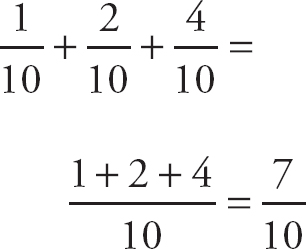
Why Bother?
You may be wondering why, if the GRE allows the use of a calculator, you should bother learning how to add or subtract fractions or to reduce them or even know any of the topics covered in the next few pages. While it’s true that you can use a calculator for these tasks, for many problems it’s actually slower to do the math with the calculator than without. Scoring well on the GRE Math section requires a fairly strong grasp of the basic relationships among numbers, fractions, percents, and so on, so it’s in your best interest to really understand these concepts rather than to rely on your calculator to get you through the question. In fact, if you put in the work now, you’ll be surprised at how easy some of the problems become, especially when you don’t have to refer constantly to the calculator to perform basic operations.
In order to add or subtract fractions that have different denominators, you need to start by finding a common denominator. You may remember your teachers from grade school imploring you to find the “lowest common denominator.” Actually, any common denominator will do, so find whichever one you find most comfortable working with.

Here, we expanded the fraction  into the equivalent fraction
into the equivalent fraction  by multiplying both the numerator and denominator by 3. Similarly, we converted
by multiplying both the numerator and denominator by 3. Similarly, we converted  to
to  by multiplying both denominator and numerator by 2. This left us with two fractions that had the same denominator, which meant that we could simply subtract their numerators.
by multiplying both denominator and numerator by 2. This left us with two fractions that had the same denominator, which meant that we could simply subtract their numerators.
When adding and subtracting fractions, you can also use a technique we call the Bowtie. The Bowtie method accomplishes exactly what we just did in one fell swoop. To use the Bowtie, first multiply the denominators of each fraction. This gives you a common denominator. Then multiply the denominator of each fraction by the numerator of the other fraction. Take these numbers and add or subtract them—depending on what the question asks you to do—to get the numerator of the answer. Then reduce if necessary.

and
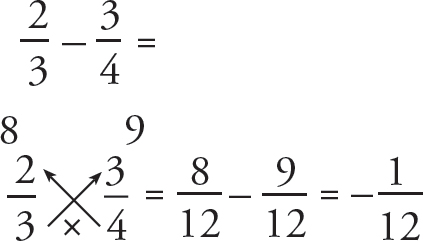
Multiplying Fractions
Multiplying fractions is relatively straightforward when compared to addition or subtraction. To successfully multiply fractions, multiply the first numerator by the second numerator and the first denominator by the second denominator. Here’s an example:

When multiplying fractions, you can make your life easier by reducing before you multiply. Do this once again by dividing out common factors.

Also remember that when you’re multiplying fractions, you can even reduce diagonally; as long as you’re working with a numerator and a denominator of opposite fractions, they don’t have to be in the same fraction. So you end up with:

Of course, you get the same answer no matter what method you use, so attack fractions in whatever fashion you find easiest.
Dividing Fractions
Dividing fractions is just like multiplying fractions, with one crucial difference: Before you multiply, you have to to find the reciprocal of the second fraction. To do this, all you need to do is flip the fraction upside down! Put the denominator on top of the numerator and then multiply just like before. In some cases, you can also reduce before you multiply. Here’s an example:

ETS tests problems that involve fractions which have numerators or denominators that are themselves fractions. These problems might look intimidating, but if you’re careful, you won’t have any trouble with them. All you have to do is remember what we said about a fraction being shorthand for division. Always rewrite the expression horizontally. Here’s an example:

Comparing Fractions
Sometimes ETS will test your ability to compare two fractions to decide which is greatest. These are typically found on quant comp questions. There are a couple of ways to accomplish this. One is to find equivalent fractions that have a common denominator. If the fraction is fairly simple this is a good strategy, but oftentimes the common denominator may be hard to find or work with.
If the denominator is hard to find or work with, you can use a variant of the Bowtie technique. In this variant, you don’t have to multiply the denominators together; instead, just multiply the denominators and the numerators. The fraction with the greater product in its numerator is the greater fraction. Let’s say we had to compare the following fractions:
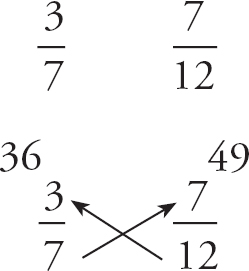
Multiplying the first denominator by the second numerator yields 49. This means the numerator of the second fraction  is 49. Multiplying the second denominator by the first numerator gives you 36, which means the first fraction has a numerator of 36. Since 49 is greater than 36,
is 49. Multiplying the second denominator by the first numerator gives you 36, which means the first fraction has a numerator of 36. Since 49 is greater than 36,  is greater than
is greater than  .
.
Comparing More Than Two Fractions
You may also be asked to compare more than two fractions. On these types of problems, don’t waste time trying to find a common denominator for all of them. Simply use the Bowtie to compare two of the fractions at a time.
Here’s an example:

Which of the following statements is true?










Here’s How to Crack It
As you can see, it would be a nightmare to try to find common denominators for all these fractions, so instead we’ll use the Bowtie method. Simply multiply the denominators and numerators of a pair of fractions and note the results. For example, to check answer choice (A), we first multiply 8 and 2, which gives us a numerator of 16 for the fraction  . But multiplying 9 and 3 gives us a numerator of 27 for the first fraction. This means that
. But multiplying 9 and 3 gives us a numerator of 27 for the first fraction. This means that  is greater than
is greater than  , and we can eliminate choice (A), because the first part of it is wrong. Here’s how the rest of the choices shape up:
, and we can eliminate choice (A), because the first part of it is wrong. Here’s how the rest of the choices shape up:

 Compare
Compare  and
and  ;
;  is greater. Eliminate (B).
is greater. Eliminate (B).

 These fractions are in order.
These fractions are in order.


 is greater than
is greater than  . Eliminate (D).
. Eliminate (D).


 is greater than
is greater than  . Eliminate (E).
. Eliminate (E).
The answer is (C).

Converting Mixed Numbers into Fractions
A mixed number is a number that is represented as an integer and a fraction, such as 2 . In most cases on the GRE, you should get rid of mixed fractions by converting them to improper fractions. How do you do this? By multiplying the denominator of the fraction by the integer, then adding that result to the numerator, and then putting the whole thing over the denominator. In other words, for the fraction above we would get
. In most cases on the GRE, you should get rid of mixed fractions by converting them to improper fractions. How do you do this? By multiplying the denominator of the fraction by the integer, then adding that result to the numerator, and then putting the whole thing over the denominator. In other words, for the fraction above we would get  or
or  .
.
The result,  , is equivalent to 2
, is equivalent to 2 . The only difference is that
. The only difference is that  is easier to work with in math problems. Also, answer choices are usually not given in the form of mixed numbers.
is easier to work with in math problems. Also, answer choices are usually not given in the form of mixed numbers.
Decimals
Decimals are just fractions in disguise. Basically, decimals and fractions are two different ways of expressing the same thing. Every decimal can be written as a fraction, and every fraction can be written as a decimal. For example, the decimal 0.35 can be written as the fraction  : These two numbers, 0.35 and
: These two numbers, 0.35 and  , have the same value.
, have the same value.
To turn a fraction into its decimal equivalent, all you have to do is divide the numerator by the denominator. Here, for example, is how you would find the decimal equivalent of  :
:

Try this problem:

 +
+ = x
= x
y = 3
| Quantity A | Quantity B |
 |
4 |
 Quantity A is greater.
Quantity A is greater.
 Quantity B is greater.
Quantity B is greater.
 The two quantities are equal.
The two quantities are equal.
 The relationship cannot be determined from the information given.
The relationship cannot be determined from the information given.
Here’s How to Crack It
Begin this quant comp question by solving for x. The common denominator is easy to find, as it is 15, so adjust the fractions to have the denominator of 15.

The problem gives the value of y so now solve for Quantity A. Quantity A is  which equals
which equals  . Now compare this to Quantity B. Dividing 45 by 11 yields a result slightly greater than 4, which means that Quantity A is greater than Quantity B and the correct answer is (A).
. Now compare this to Quantity B. Dividing 45 by 11 yields a result slightly greater than 4, which means that Quantity A is greater than Quantity B and the correct answer is (A).

Comparing Decimals
Which is greater: 0.00099 or 0.001? ETS loves this sort of problem. You’ll never go wrong, though, if you follow these easy steps.
• Line up the numbers by their decimal points.
• Fill in the missing zeros.
Here’s how to answer the question we just asked. First, line up the two numbers by their decimal points.
0.00099
0.001
Now fill in the missing zeros.
0.00099
0.00100
Can you tell which number is greater? Of course you can. 0.00100 is greater than 0.00099, because 100 is greater than 99.
Digits and Decimals
Sometimes ETS will ask you questions about digits that fall after the decimal point as well. Suppose you have the number 0.584.
• 0 is the units digit.
• 5 is the tenths digit.
• 8 is the hundredths digit.
• 4 is the thousandths digit.
Percentages
A percentage is just a special type of fraction, one that always has 100 as the denominator. Percent literally means “per 100” or “out of 100” or “divided by 100.” If your best friend finds a dollar and gives you 50¢, your friend has given you 50¢ out of 100, or  of a dollar, or 50 percent of the dollar. To convert fractions to percentages, just expand the fraction so it has a denominator of 100:
of a dollar, or 50 percent of the dollar. To convert fractions to percentages, just expand the fraction so it has a denominator of 100:

For the GRE, you should memorize the following percentage-decimal-fraction equivalents. Use these friendly fractions and percentages to eliminate answer choices.
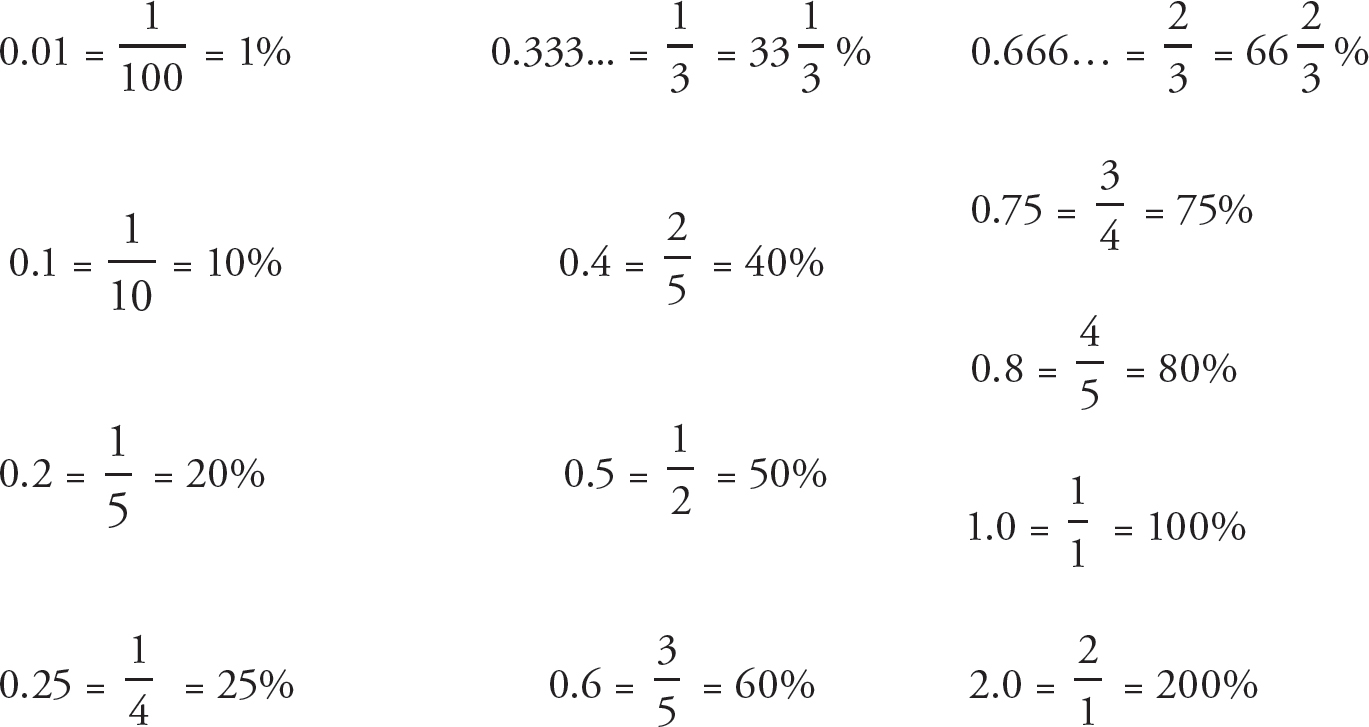
Converting Decimals to Percentages
In order to convert decimals to percentages, just move the decimal point two places to the right. For example, 0.8 turns into 80 percent, 0.25 into 25 percent, 0.5 into 50 percent, and 1 into 100 percent.
Translation
One of the best ways to handle percentages in word problems is to know how to translate them into an equation that you can manipulate. Use the following table to help you translate percentage word problems into equations you can work with.
| Word | Equivalent Symbol |
|---|---|
| percent | 100 |
| is | = |
| of, times, product | × |
| what (or any unknown value) | any variable (x, k, b) |
Here’s an example:

56 is what percent of 80 ?
 66%
66%
 70%
70%
 75%
75%
 80%
80%
 142%
142%
Here’s How to Crack It
To solve this problem, let’s translate the question and then solve for the variable. So, “56 is what percent of 80,” in math speak, is equal to
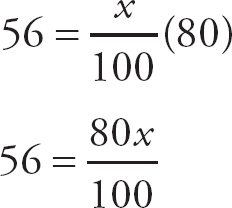
Don’t forget to reduce the fraction: 56 =  x.
x.
Now multiply both sides of the equation by the reciprocal,  .
.
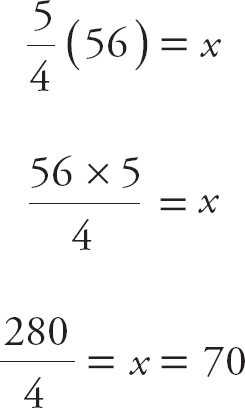
The correct answer is (B), 70%.

Let’s try a quant comp example.

5 is r percent of 25
s is 25 percent of 60
| Quantity A | Quantity B |
| r | s |
 Quantity A is greater.
Quantity A is greater.
 Quantity B is greater.
Quantity B is greater.
 The two quantities are equal.
The two quantities are equal.
 The relationship cannot be determined from the information given.
The relationship cannot be determined from the information given.
Here’s How to Crack It
First translate the first statement.

That takes care of Quantity A. Now translate the second statement.
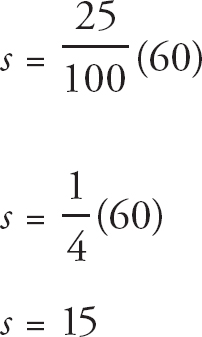
So Quantity A is greater than Quantity B. The answer is (A).

Percentage Increase/Decrease
Rather than asking for percents, ETS typically will test your knowledge by asking for percent change. Percent change is the percentage by which something has increased or decreased. To find percent change, use the following formula.
Percent Change =  × 100
× 100
When presented with a percent change problem, you will typically be given two numbers. The “difference” is the result when the lesser number is subtracted from the greater number. The “original” is whichever number you started with. If the question asks you to find a percent increase, then the original number is the lesser number. If the question asks you to find a percent decrease, then the original number is the greater number.
On the GRE, a percent change will not be stated as a negative number. Instead, the problem will ask for a percent decrease. So, if something declined by 50%, the problem will ask for a percent decrease and the answer will be stated as 50%. Note that when you use the percent change formula, you always subtract the lesser number from the greater number to find the difference. Doing so ensures that you get a positive result.
Here’s an example.

During a certain three-month period, Vandelay Industries reported a $3,500 profit. If, over the next three-month period, Vandelay Industries reported $6,000 profit for those months, by approximately what percent did Vandelay Industries profit increase?
 25%
25%
 32%
32%
 42%
42%
 55%
55%
 70%
70%
Here’s How to Crack It
Let’s use the percent change formula we just learned. The first step is to find the difference between the two numbers. The initial profit was $3,500 and the final profit is $6,000. The difference between these two numbers is 6,000 − 3,500 = 2,500. Next, we need to divide this number by the original, or starting, value.
One way to help you figure out what value to use as the original value is to check to see whether you’re dealing with a percent increase or a percent decrease question. Remember that on a percent increase question, you should always use the lesser of the two numbers as the denominator and on a percent decrease question you need to use the greater of the two numbers as the denominator. Because the question asks to find the percent increase, the number we want to use for our denominator is 3,500. The percent increase fraction looks like this:  . This can be reduced to
. This can be reduced to  by dividing by 100, and reduced even further by dividing by 5. The reduced fraction is
by dividing by 100, and reduced even further by dividing by 5. The reduced fraction is  , which is approximately 70% (remember that the fraction bar means divide, so if you divide 5 by 7, you’ll get 0.71). Thus, (E) is the correct answer.
, which is approximately 70% (remember that the fraction bar means divide, so if you divide 5 by 7, you’ll get 0.71). Thus, (E) is the correct answer.

Here’s another question.

| Model | Original Price | Sale Price |
|---|---|---|
| A | $12,000 | $9,500 |
| B | $16,000 | $13,000 |
| C | $10,000 | $7,500 |
| D | $17,500 | $13,000 |
| E | $20,000 | $15,500 |
| F | $22,000 | $16,000 |
The table above shows the original price and the sale price for six different models of cars. For which car models is the difference between the original price and the sale price greater than or equal to 25% ?
Indicate all such models.
 A
A
 B
B
 C
C
 D
D
 E
E
 F
F
Here’s How to Crack It
The task of the question is to identify a 25% change or greater between the two prices for the different car models. Use the percent change formula for all of the models to solve this question. Start with model A. Using the calculator, subtract 9,500 from 12,000 to get 2,500. This is the difference. Divide it by the original, 12,000, to get 0.2, which when multiplied by 100 is 20%. Since 20% is less than 25%, eliminate (A). Try the next one. 16,000 − 13,000 = 3,000. Divide 3,000 by 16,000. The result is less than 25%, so eliminate (B). Repeat this process for each of the answer choices. Choices (C), (D), and (F) are the correct answers.

A FEW LAWS
These two basic laws are not necessary for success on the GRE, so if you have trouble with them, don’t worry too much. However, ETS likes to use these laws to make certain math problems more difficult. If you’re comfortable with these two laws, you’ll be able to simplify problems using them, so it’s definitely worth it to use them.
Associative Laws
There are two associative laws—one for addition and one for multiplication. For the sake of simplicity, we’ve lumped them together.
Here’s what you need to know:
When you are adding or multiplying a series of numbers, you can regroup the numbers in any way you’d like.
Here are some examples:
4 + (5 + 8) = (4 + 5) + 8 = (4 + 8) + 5
(a + b) + (c + d) = a + (b + c + d)
4 × (5 × 8) = (4 × 5) × 8 = (4 × 8) × 5
(ab)(cd) = a(bcd)
Distributive Law
This is often tested on the GRE. Here’s what it looks like:
a(b + c) = ab + ac
a(b − c) = ab − ac
Here’s an example:

12(66) + 12(24) = ?
Here’s How to Crack It
This is in the same form as ab + ac. Using the distributive law, this must equal 12(66 + 24), or 12(90) = 1,080.

Math Fundamentals Drill
Test your new skills and check your answers in Part V.
If a prime number, p, is squared and the result is added to the next prime number greater than p, which of the following integers could be the resulting sum?
Indicate all such integers.
 3
3
 4
4
 7
7
 14
14
 58
58
 60
60
 65
65
 69
69
A bookstore will only order books that come in complete cases. Each case has 150 books and costs $1,757.
| Quantity A | Quantity B |
| The number of books that can be ordered for $10,550 | The number of books that can be ordered for $12,290 |
 Quantity A is greater.
Quantity A is greater.
 Quantity B is greater.
Quantity B is greater.
 The two quantities are equal.
The two quantities are equal.
 The relationship cannot be determined from the information given.
The relationship cannot be determined from the information given.
If the product of two distinct integers is 91, then which of the following values could represent the sum of the two integers?
Indicate all possible values.
 −92
−92
 −91
−91
 7
7
 13
13
 20
20
What is the value of the ones digit for the sum of all of the distinct prime integers less than 20 ?
 4
4
 5
5
 6
6
 7
7
 8
8
During a sale, a store decreases the prices on all of its scarves by 25 to 50 percent. If all of the scarves in the store were originally priced at $20, which of the following prices could be the sale price of a scarf?
Indicate all such prices.
 $8
$8
 $10
$10
 $12
$12
 $14
$14
 $16
$16
On Monday, 40 of the 160 available books in a library’s collection were borrowed. On Tuesday, half of the books borrowed on Monday were returned and on Wednesday half of the remaining borrowed books from Monday were returned. On Thursday, the library receives 30 more available books, and a sixth of the remaining borrowed books from Monday are returned. On Friday, 30 more books are borrowed and on Saturday 35 more books are borrowed. If no other books were borrowed, returned, or received during the week, what is the percent change of the available books at the end of the day Monday to the available books at the end of the day on Saturday?
| Quantity A | Quantity B |
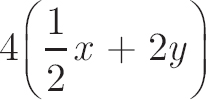 |
2x + 8y |
 Quantity A is greater.
Quantity A is greater.
 Quantity B is greater.
Quantity B is greater.
 The two quantities are equal.
The two quantities are equal.
 The relationship cannot be determined from the information given.
The relationship cannot be determined from the information given.
| Quantity A | Quantity B | |
| The greatest number of distinct nonnegative consecutive integers whose sum is less than 22 | 6 |
 Quantity A is greater.
Quantity A is greater.
 Quantity B is greater.
Quantity B is greater.
 The two quantities are equal.
The two quantities are equal.
 The relationship cannot be determined from the information given.
The relationship cannot be determined from the information given.
If x is the remainder when a multiple of 4 is divided by 6, and y is the remainder when a multiple of 2 is divided by 3, what is the greatest possible value of x + y ?
 2
2
 3
3
 5
5
 6
6
 9
9
What is the value of the expression 12 − 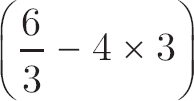 − 8 × 3?
− 8 × 3?
 −46
−46
 −30
−30
 −18
−18
 −6
−6
 −2
−2
Summary
○ Familiarity with the basic math concepts on the GRE is essential to achieving a great score.
○ Digits are the numbers that make up other numbers, which are collections of digits, and those other numbers are determined by the place value of the digits.
○ Integers are numbers with no fractional part (such as −6, −1, 1, 10, etc.) and can be positive or negative, and even or odd.
○ Zero is an integer that is neither positive nor negative.
○ Consecutive integers are integers listed in some sort of order.
○ The absolute value of a number is that numbers distance away from zero on a number line.
○ A factor is a number that evenly divides into a greater number.
○ A multiple of a number is a number that has an original number as a factor.
○ Prime numbers only have two factors: 1 and the number itself.
○ Divisibility is the ability for one number to be divided into another number with a result that is an integer. If a number divided by another number and the result is not an integer, the amount that is leftover is called the remainder.
○ Always follow the order of operations when working a math problem.
○ Fractions, decimals, and percents are all ways of expressing parts of integers and can be manipulated and compared.
○ The associative and distributive laws are useful ways to group and regroup numbers.


